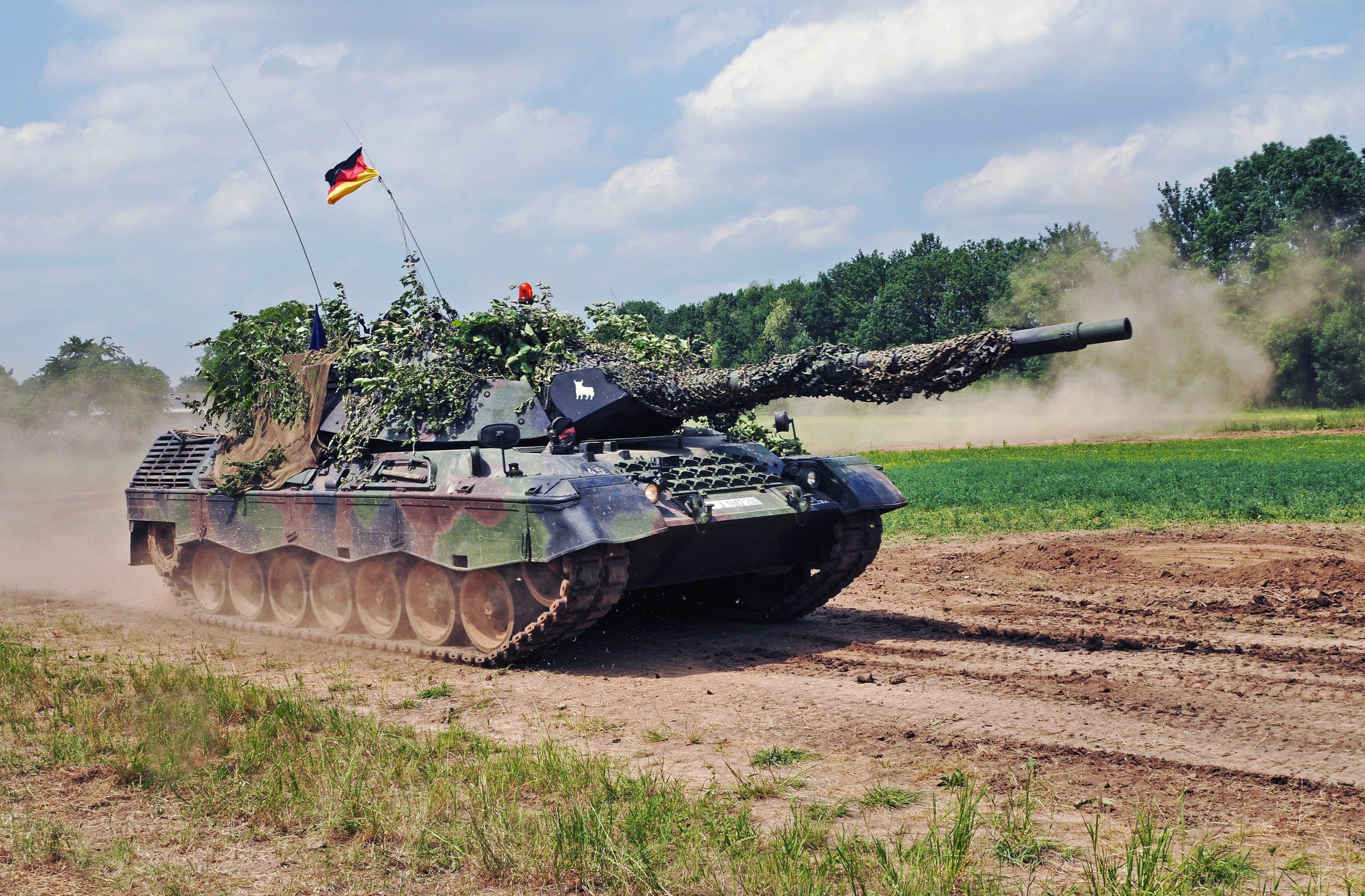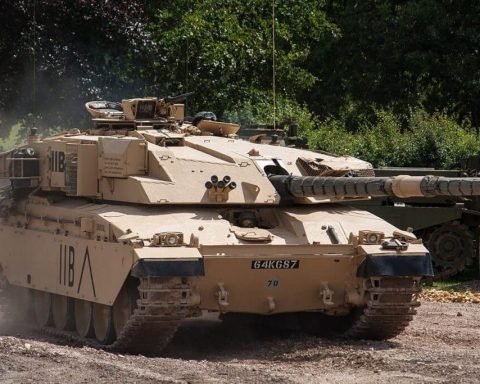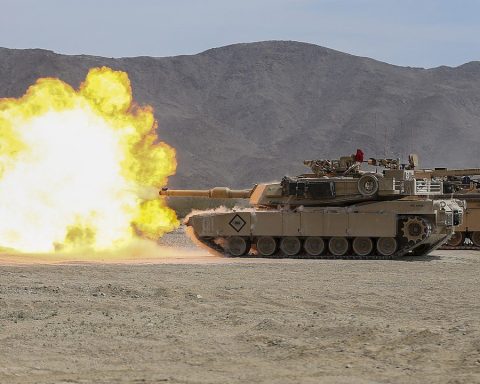The German Leopard 1 tank was designed based on the concept that HEAT warheads had rendered heavy armor obsolete, leaving speed the only defense. It was very lightly armored for a tank of its era, only meant to resist autocannons. This did, however, give it excellent mobility thanks to the lightweight. It is a well-designed tank from a chassis and platform standpoint: excellent mobility, excellent upgradability, and high quality. It also had as big a part in M1 Abrams development as M60 did.
Key recognition features
- Well, sloped glacis plate leads up to horizontal hull top extending right to the rear of the hull, driver’s hatch in the right side of the roof to the immediate rear of glacis plate, turret center, engine rear, hull rear slopes slightly inwards. Hull sides above suspension slope inwards with horizontal louvers above rear drive sprocket.
- Cast turret with sides sloping inwards, external mantlet and 105mm gun with a thermal sleeve and fume extractor, infra-red/white light searchlight often mounted above gun mantlet, stowage basket on turret rear, smoke grenade discharges on turret sides towards the rear
- Suspension on each side has seven road wheels, a wider front, drive sprocket rear, and four-track return rollers. Skirts often cover the upper part.
Development
Leopard 1 was developed in the late 1950s, and after trials with various prototypes, Krauss-Maffei of Munich was selected as the prime contractor in 1963, with MaK responsible for the specialized versions.
The first tank was delivered to the German Army in 1965, and production continued, with interruptions, until 1984. OTOBREDA produced Leopard 1 for the Italian Army, and MaK built a small quantity for home and export markets.

The driver sits front right with an NBC pack and some ammunition to his left, turret center, engine, and transmission rear. Commander and gunner sit on the right side of the turret, loader left.
The 105mm gun is fully stabilized and power-elevates from 9 degrees to 20 degrees with a turret traversing 360 degrees. Types of ammunition include APDS, APFSDS, HEAT, and smoke. A 7.62mm machine gun is mounted coaxially to the left of a 105mm gun, and a similar weapon can be mounted on the commander’s or loader’s hatch,
A wide range of optional equipment is available, including additional armor, different fire-control system, various night vision devices, and a dozer blade. Many armies, including Germany, have upgraded their Leopard 1s to extend their lives into the 1990s.
Variants
- Leopard 1A1A1 has several improvements, including additional armor protection for the turret.
- Leopard 1A2 has passive night equipment for the commander and driver and an improved turret.
- Leopard 1A3 has a new all-welded turret with improved armor and all the improvements of Leopard 1A2 and Leopard 1A3.
- Leopard 1A4 was the final model for the German Army and had an all-welded turret and integrated fire-control system.
- Leopard 1A5 is the latest upgrade for the German Army and has a new computerized fire control system and thermal night vision equipment.
- Leopard 1 with 105mm Improved Weapon System, trials only.
- Leopard 1 with 120mm gun of Leopard 2, trials only.
- Leopard 1 AVLB (Biber)
- Leopard 1 ARV
- Leopard 1 AEV
- Flakpanzer Gepard twin 35mm self-propelled anti-aircraft system
- Leopard 1 driver training tank has a large observation type cupola in place of the turret.
- Leopard 1 chassis has also been proposed as a carrier for the Roland surface-to-air missile system, Italian 76mm OTOMATIC anti-aircraft/anti-helicopter weapon, and turret of French GCT 155mm self-propelled gun, but none has entered service.
Status
Production complete. In service with Australia, Belgium, Botswana, Brazil, Canada, Denmark, Germany, Greece, Italy, Netherlands, Norway, and Turkey.
Technical specification
| Country of origin: | Germany |
| Manufacturers: | Kraus-Maffei, Munich and MaK, Kiel, Germany; OTOBREDA La Spezia, Italy |
| Crew: | 4 |
| Armament: | 1 x 105 mm, 1 x 7.62 mm machine gun (coaxial), 1 x 7.62 mm machine gun (anti-aircraft), 2 x 4 smoke grenade dischargers |
| Ammunition: | 60 x 105 mm, 5,500 x 7.62 mm |
| Length gun forwards: | 9.543 m |
| Length hull: | 7.09 m |
| Width without skirts: | 3.25 m |
| Height to top of commander’s periscope: | 2.613 m |
| Ground clearance: | 0.44 m |
| Weight, combat: | 40,000 kg |
| Weight, empty: | 38,700 kg |
| Power-to-weight ratio: | 20.75 hp/tonne |
| Ground pressure: | 0.86 kg/cm2 |
| Engine: | MTU MB 838 Ca M500, 10-cylinder multi-fuel developing 830hp at 2,200rpm |
| Maximum road speed: | 65 km/h |
| Maximum road range: | 600 km |
| Fuel capacity: | 955 lit |
| Fording: | 2.25 m, 4 m (with preparation) |
| Vertical obstacle: | 1.15 m |
| Trench: | 3 m |
| Gradient: | 60% |
| Side slope: | 30% |
| Armor: | 70 mm (maximum) |
| Armor type: | steel |
| NBC system: | Yes |
| Night vision equipment: | Yes (it was infra-red, now replaced by passive in some armies) |










The West German doctrine of speed over armor was never put to the real peer to peer test in period iof 1970-80’s. These tanks (1A5 variants) have been dusted off and given to Ukraine Armed Forces and the results have shown the original doctrine has proven less than effective. Two caveats: modern infantry anti-tank weapons are are much more prevalent now and UAF has tended to use Leo 1A5 in accordance with own tactical dotrine. Other western tanks of same era went with heavier armor and sloped armor effect. The Leo 1A5 has been slaughtered in both northern Syria (Turkish Leo tanks hit by Kurdish Konkurs ATGM operators) and in Ukraine (Rus Fed Armed Forces using everything from ATGM to FPV Suicide Drones mounted with shaped charge RPG warheads).
Verdict:
Took decades for the real test to occur – and was found wanting: meaning Doctrinal Fail.